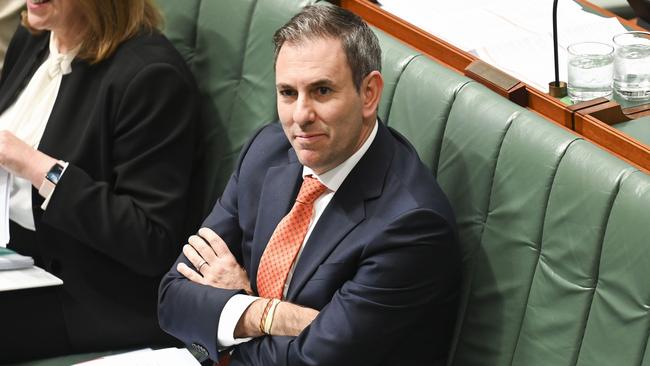Interest rates warning: RBA looms as tax-cut killer
A rate hike at next month’s Reserve Bank meeting would erase the benefit of real wage rises and stage three tax cuts for struggling household borrowers, Deloitte has warned.

A rate hike at next month’s Reserve Bank meeting would erase the benefit of real wage rises and stage-three tax cuts for struggling household borrowers, Deloitte has warned, in a move that would undercut Labor’s signature cost-of-living measure and derail Anthony Albanese’s election pitch.
Deloitte Access Economics is warning an interest-rate increase by the central bank on its August 6 meeting would “crush” household and business confidence while “wiping out the benefits of tax cuts and real wage gains in the second half of 2024”.
The Deloitte business outlook report says June inflation figures to be released next week would set the course for the economy for the rest of the year, with the RBA likely to raise the cash rate to 4.6 per cent if the data shows price growth failing to moderate.
A rise in interest rates in August or September is set to put pressure on the strategies of the Albanese government and the RBA, with some leading economists arguing that the central bank should have increased the cash rate further than its last hike to 4.35 per cent in November last year.
With economists and the Coalition warning that increased spending in state and federal budgets was making the RBA’s job harder, research from ANZ released on Wednesday said government expenditure was growing too fast at an average annual rate of 5 per cent since 2015. “The strongest monetary policy implication we draw is that, in the absence of a much sharper decline in public final demand, the 2025 easing cycle in Australia is likely to be shallow,” wrote ANZ’s head of Australian economics Adam Boyton.
The Deloitte report predicted economic growth would slow to 1.2 per cent this financial year, before rising to 2.1 per cent in 2025-26 and 2.3 per cent 2026-27 – a scenario that supports the Prime Minister’s narrative of a strengthening economy.

But the report argues its growth forecasts would be at risk if there were another rate rise, saying it “might just be the proverbial straw on the camel’s back”.
“With households feeling like interest rates have peaked, and there’s tax cuts, other support payments and real wage gains, it would be pretty heartbreaking for households that are on the borderline, to have a rate hike,” said Deloitte partner Stephen Smith.
“I think for households who have a mortgage at the average level, (a rate hike) would certainly wipe out that increase in take-home pay tax cuts that households have been looking forward to.”
Despite expecting the Reserve Bank to keep the cash rate on hold at next month’s meeting, Mr Smith said a hike would be “on the table” if inflation came in at 1 per cent or above for the June quarter, a figure that would bring the annual rate to 4 per cent.
Trimmed mean inflation – the RBA’s preferred measure of underlying price pressures which strips out volatile items such as petrol – is forecast by the central bank to ease to 3.8 per cent in the 12 months to June.
Jim Chalmers said Deloitte’s report had vindicated Labor’s economic plan.
“Fiscal policy isn’t a primary determinant of prices in our economy but our budget’s helping to take some of the edge off inflation, which would be higher without our efforts,” the Treasurer said.
“The report makes the really important conclusion that people would be under even more pressure were it not for our balanced approach.”
Former Reserve Bank official and Challenger chief economist Jonathan Kearns said Australians were paying the price for the caution shown by the RBA, arguing that rates should have been increased to about 5 per cent at the beginning of the year.
“Almost all of the deceleration has come through in traded goods,” Dr Kearns said.
“That’s just the unwinding of the supply chain, the reduction in energy prices. Obviously there’s some effect of the tightening in monetary policy, but not enough.
“If the RBA ends up having to increase rates after the June quarter CPI, then I think that effectively is an admission that rates should have been higher.”
Deutsche Bank chief economist Phil O’Donaghoe said the RBA’s cash rate was not restrictive enough to tame persistent price growth, and tipped borrowers would be forced to stomach an additional increase.
“If the RBA knew where the monthly inflation indicator was going to be sitting by the end of May, I think they would have hiked back in December … We would have faced a higher cash rate in 2024,” Mr O’Donaghoe said.
However, ex-RBA assistant governor turned Westpac chief economist Luci Ellis said that, had the RBA taken a similarly aggressive approach to other central banks, the effect would be minimal.
“The difference between what the RBA did and what others did is worth maybe 0.2 to 0.3 percentage points off inflation – that’s not a fantastic trade-off,” Dr Ellis said.
“Most of the inflation we’ve seen in the recent episode has had as its essence, the supply shocks. There has been a demand element as well, but in Australia that demand in part has faded pretty quickly.”
Alongside Mr O’Donaghoe, analysts at Citi, Judo Bank and UBS are all pencilling in an August rate hike.
After fresh labour market data released last week showed jobs growth was 2.8 per cent in the year to June, well outpacing the RBA’s forecast of a 2.1 per cent rise, investors lifted their bets of an August increase to 21 per cent.
At the central bank’s September meeting, the odds of further tightening has neared one in three.
Money markets are not fully priced for a rate cut until July next year, months after a federal election must be held.
An additional quarter point interest rate rise would add about $112 in monthly repayments to a standard $750,000 owner-occupier loan, which has already risen by $1816 since May 2022, according to analysis by RateCity.





To join the conversation, please log in. Don't have an account? Register
Join the conversation, you are commenting as Logout